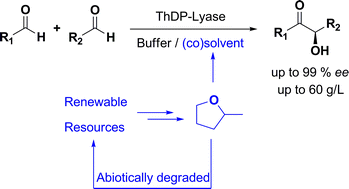Enzyme-catalyzed C–C bond formation using 2-methyltetrahydrofuran (2-MTHF) as (co)solvent: efficient and bio-based alternative to DMSO and MTBE
Abstract
The enzymatic carboligation of aldehydes (C–C bond formation) catalyzed by benzaldehyde lyase (

* Corresponding authors
a
Institute of Technical and Macromolecular Chemistry (ITMC), RWTH Aachen University, Worringerweg 1, Aachen, Germany
E-mail:
dominguez@itmc.rwth-aachen.de
Fax: +49 241 8022177
Tel: +49 241 8020468
b
DECHEMA e.V. Karl-Winnacker-Institut, Theodor-Heuss-Allee 25, Frankfurt am Main, Germany
E-mail:
greiner@dechema.de
Fax: +49 697564388
Tel: +49 697564337
The enzymatic carboligation of aldehydes (C–C bond formation) catalyzed by benzaldehyde lyase (

 Please wait while we load your content...
Something went wrong. Try again?
Please wait while we load your content...
Something went wrong. Try again?
S. Shanmuganathan, D. Natalia, A. van den Wittenboer, C. Kohlmann, L. Greiner and P. Domínguez de María, Green Chem., 2010, 12, 2240 DOI: 10.1039/C0GC00590H
To request permission to reproduce material from this article, please go to the Copyright Clearance Center request page.
If you are an author contributing to an RSC publication, you do not need to request permission provided correct acknowledgement is given.
If you are the author of this article, you do not need to request permission to reproduce figures and diagrams provided correct acknowledgement is given. If you want to reproduce the whole article in a third-party publication (excluding your thesis/dissertation for which permission is not required) please go to the Copyright Clearance Center request page.
Read more about how to correctly acknowledge RSC content.
 Fetching data from CrossRef.
Fetching data from CrossRef.
This may take some time to load.
Loading related content
